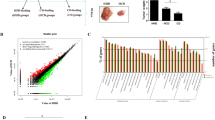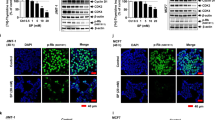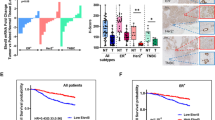Abstract
Although epidemiological and preclinical studies have shown the preventative effects of n-3 polyunsaturated fatty acids (PUFAs) on breast cancer, inconsistencies still remain in the data and the underlying mechanisms remain unclear. In this study, we identified mammalian target of rapamycin (mTOR) signaling, which plays an essential role in cell proliferation and breast tumorigenesis, as a target of n-3 PUFAs. In breast cancer cell lines, n-3 PUFAs rapidly and efficiently suppress both mTOR complex 1 (mTORC1) and mTORC2 and their downstream signaling, and subsequently inhibit cell proliferation and angiogenesis while promoting apoptosis. Further study indicates that stabilization of the mTOR-raptor complex by n-3 PUFAs may contribute to their inhibitory effect on mTORC1. Importantly, four complementary and well-controlled animal models were utilized to identify the role and molecular target of n-3 PUFAs in the prevention of breast carcinogenesis and progression, namely: (1) chemically induced mammary tumor rats with a high dietary intake of n-3 PUFAs; (2) nude mice implanted with mammary tumor cell lines stably expressing fat-1, a desaturase that catalyzes the conversion of n-6 to n-3 PUFAs and produces n-3 PUFAs endogenously; (3) fat-1 transgenic severe combined immune deficiency mice implanted with breast tumor cells; and (4) the fat-1 transgenic mouse mammary tumor virus-polyoma virus middle T oncogene double-hybrid mice, a model of aggressive breast cancer. In summary, dietary and endogenous n-3 PUFAs abrogate the activity of mTORC1/2 pathways in vitro and in vivo and prevent breast carcinogenesis, tumor growth and metastasis. Taken together, our findings convincingly clarify the causal relationship between n-3 PUFAs and breast cancer prevention and establish mTORC1/2 as a target of n-3 PUFAs.
This is a preview of subscription content, access via your institution
Access options
Subscribe to this journal
Receive 50 print issues and online access
$259.00 per year
only $5.18 per issue
Buy this article
- Purchase on Springer Link
- Instant access to full article PDF
Prices may be subject to local taxes which are calculated during checkout






Similar content being viewed by others
References
Warner E . Clinical practice. Breast-cancer screening. N Engl J Med. 2011; 365: 1025–1032.
Schatzkin A, Greenwald P, Byar DP, Clifford CK . The dietary fat—breast cancer hypothesis is alive. JAMA 1989; 261: 3284–3287.
Engeset D, Alsaker E, Lund E, Welch A, Khaw KT, Clavel-Chapelon F et al. Fish consumption and breast cancer risk. The European Prospective Investigation into Cancer and Nutrition (EPIC). Int J Cancer 2006; 119: 175–182.
MacLean CH, Newberry SJ, Mojica WA, Khanna P, Issa AM, Suttorp MJ et al. Effects of omega-3 fatty acids on cancer risk: a systematic review. JAMA 2006; 295: 403–415.
Gerber M . Omega-3 fatty acids and cancers: a systematic update review of epidemiological studies. Br J Nutr 2012; 107 (Suppl 2): S228–S239.
Signori C, El-Bayoumy K, Russo J, Thompson HJ, Richie JP, Hartman TJ et al. Chemoprevention of breast cancer by fish oil in preclinical models: trials and tribulations. Cancer Res 2011; 71: 6091–6096.
Manni A, Xu H, Washington S, Aliaga C, Cooper T, Richie JP Jr et al. The impact of fish oil on the chemopreventive efficacy of tamoxifen against development of N-methyl-N-nitrosourea-induced rat mammary carcinogenesis. Cancer Prev Res (Phila) 2010; 3: 322–330.
Cohen LA, Chen-Backlund JY, Sepkovic DW, Sugie S . Effect of varying proportions of dietary menhaden and corn oil on experimental rat mammary tumor promotion. Lipids 1993; 28: 449–456.
Olivo SE, Hilakivi-Clarke L . Opposing effects of prepubertal low- and high-fat n-3 polyunsaturated fatty acid diets on rat mammary tumorigenesis. Carcinogenesis 2005; 26: 1563–1572.
Zoncu R, Efeyan A, Sabatini DM . mTOR: from growth signal integration to cancer, diabetes and ageing. Nat Rev Mol Cell Biol 2011; 12: 21–35.
Laplante M, Sabatini DM . mTOR signaling at a glance. J Cell Sci 2009; 122: 3589–3594.
Bai X, Jiang Y . Key factors in mTOR regulation. Cell Mol Life Sci 2010; 67: 239–253.
Laplante M, Sabatini DM . mTOR signaling in growth control and disease. Cell 2012; 149: 274–293.
Efeyan A, Sabatini DM . mTOR and cancer: many loops in one pathway. Curr Opin Cell Biol 2010; 22: 169–176.
Wen ZH, Su YC, Lai PL, Zhang Y, Xu YF, Zhao A et al. Critical role of arachidonic acid-activated mTOR signaling in breast carcinogenesis and angiogenesis. Oncogene 2013; 32: 160–170.
Wei D, Li J, Shen M, Jia W, Chen N, Chen T et al. Cellular production of n-3 PUFAs and reduction of n-6-to-n-3 ratios in the pancreatic beta-cells and islets enhance insulin secretion and confer protection against cytokine-induced cell death. Diabetes 2010; 59: 471–478.
Kang JX . A transgenic mouse model for gene-nutrient interactions. J Nutrigenet Nutrigenomics 2008; 1: 172–177.
Rose DP, Connolly JM . Effects of dietary omega-3 fatty acids on human breast cancer growth and metastases in nude mice. J Natl Cancer Inst 1993; 85: 1743–1747.
Rose DP, Connolly JM, Rayburn J, Coleman M . Influence of diets containing eicosapentaenoic or docosahexaenoic acid on growth and metastasis of breast cancer cells in nude mice. J Natl Cancer Inst 1995; 87: 587–592.
van Veelen W, Korsse SE, van de Laar L, Peppelenbosch MP . The long and winding road to rational treatment of cancer associated with LKB1/AMPK/TSC/mTORC1 signaling. Oncogene 2011; 30: 2289–2303.
Kwiatkowski DJ, Manning BD . Tuberous sclerosis: a GAP at the crossroads of multiple signaling pathways. Hum Mol Genet 2005; 2: R251–R258.
Jiang W, Zhu Z, McGinley JN, El Bayoumy K, Manni A, Thompson HJ . Identification of a molecular signature underlying inhibition of mammary carcinoma growth by dietary N-3 fatty acids. Cancer Res 2012; 72: 3795–3806.
Jing K, Song KS, Shin S, Kim N, Jeong S, Oh HR et al. Docosahexaenoic acid induces autophagy through p53/AMPK/mTOR signaling and promotes apoptosis in human cancer cells harboring wild-type p53. Autophagy 2011; 7: 1348–1358.
Kim DH, Sarbassov DD, Ali SM, King JE, Latek RR, Erdjument-Bromage H et al. mTOR interacts with raptor to form a nutrient-sensitive complex that signals to the cell growth machinery. Cell 2002; 110: 163–175.
Yoshida S, Hong S, Suzuki T, Nada S, Mannan AM, Wang J et al. Redox regulates mammalian target of rapamycin complex 1 (mTORC1) activity by modulating the TSC1/TSC2-Rheb GTPase pathway. J Biol Chem 2011; 286: 32651–32660.
Sarbassov DD, Sabatini DM . Redox regulation of the nutrient-sensitive raptor-mTOR pathway and complex. J Biol Chem 2005; 280: 39505–39509.
Ma XM, Blenis J . Molecular mechanisms of mTOR-mediated translational control. Nat Rev Mol Cell Biol 2009; 10: 307–318.
Wouters BG, Koritzinsky M . Hypoxia signalling through mTOR and the unfolded protein response in cancer. Nat Rev Cancer 2008; 8: 851–864.
Gulhati P, Bowen KA, Liu J, Stevens PD, Rychahou PG, Chen M et al. mTORC1 and mTORC2 regulate EMT, motility, and metastasis of colorectal cancer via RhoA and Rac1 signaling pathways. Cancer Res 2011; 71: 3246–3256.
Kim EK, Yun SJ, Ha JM, Kim YW, Jin IH, Yun J et al. Selective activation of Akt1 by mammalian target of rapamycin complex 2 regulates cancer cell migration, invasion, and metastasis. Oncogene 2011; 30: 2954–2963.
Gabor H, Hillyard LA, Abraham S . Effect of dietary fat on growth kinetics of transplantable mammary adenocarcinoma in BALB/c mice. J Natl Cancer Inst 1985; 74: 1299–1305.
Jurkowski JJ, Cave WT Jr. . Dietary effects of menhaden oil on the growth and membrane lipid composition of rat mammary tumors. J Natl Cancer Inst 1985; 74: 1145–1150.
Braden LM, Carroll KK . Dietary polyunsaturated fat in relation to mammary carcinogenesis in rats. Lipids 1986; 21: 285–288.
Maclennan MB, Clarke SE, Perez K, Wood GA, Muller WJ, Kang JX et al. Mammary tumor development is directly inhibited by lifelong n-3 polyunsaturated fatty acids. J Nutr Biochem 2013; 24: 388–395.
Gingras AA, White PJ, Chouinard PY, Julien P, Davis TA, Dombrowski L et al. Long-chain omega-3 fatty acids regulate bovine whole-body protein metabolism by promoting muscle insulin signalling to the Akt-mTOR-S6K1 pathway and insulin sensitivity. J Physiol 2007; 579: 269–284.
Berquin IM, Edwards IJ, Chen YQ . Multi-targeted therapy of cancer by omega-3 fatty acids. Cancer Lett 2008; 269: 363–377.
Larsson SC, Kumlin M, Ingelman-Sundberg M, Wolk A . Dietary long-chain n-3 fatty acids for the prevention of cancer: a review of potential mechanisms. Am J Clin Nutr 2004; 79: 935–945.
O'Regan R, Hawk NN . mTOR inhibition in breast cancer: unraveling the complex mechanisms of mTOR signal transduction and its clinical implications in therapy. Expert Opin Ther Targets 2011; 15: 859–872.
Xia S, Lu Y, Wang J, He C, Hong S, Serhan CN et al. Melanoma growth is reduced in fat-1 transgenic mice: impact of omega-6/omega-3 essential fatty acids. Proc Natl Acad Sci USA 2006; 103: 12499–12504.
Acknowledgements
We greatly appreciate the gift of TSC2+/+ and TSC2−/− MEFs from Dr David J Kwiatkowski (Brigham and Women’s Hospital, Boston, MA, USA). This work was supported by the State Key Development Program for Basic Research of China (2009CB918904, 2013CB945203), National Natural Sciences Foundation of China (91029727), Guangdong Natural Science Foundation (s2012010008209) and Program for Changjiang Scholars and Innovative Research Team in University (IRT1142). TSC2+/+P53−/−and TSC2−/−P53−/− mouse embryonic fibroblasts (MEF) were provided by Dr David J Kwiatkowski (Brigham and Women's Hospital, Boston, MA, USA).
Author information
Authors and Affiliations
Corresponding authors
Ethics declarations
Competing interests
The authors declare no conflict of interest.
Additional information
Supplementary Information accompanies this paper on the Oncogene website
Supplementary information
Rights and permissions
About this article
Cite this article
Chen, Z., Zhang, Y., Jia, C. et al. mTORC1/2 targeted by n-3 polyunsaturated fatty acids in the prevention of mammary tumorigenesis and tumor progression. Oncogene 33, 4548–4557 (2014). https://doi.org/10.1038/onc.2013.402
Received:
Revised:
Accepted:
Published:
Issue Date:
DOI: https://doi.org/10.1038/onc.2013.402
Keywords
This article is cited by
-
Blood n-3 fatty acid levels and total and cause-specific mortality from 17 prospective studies
Nature Communications (2021)
-
UBAP2L arginine methylation by PRMT1 modulates stress granule assembly
Cell Death & Differentiation (2020)
-
Omega-3 Polyunsaturated Fatty Acids Attenuate Fibroblast Activation and Kidney Fibrosis Involving MTORC2 Signaling Suppression
Scientific Reports (2017)
-
Inhibition of colon cancer growth by docosahexaenoic acid involves autocrine production of TNFα
Oncogene (2016)
-
Elevation of ω-3 Polyunsaturated Fatty Acids Attenuates PTEN-deficiency Induced Endometrial Cancer Development through Regulation of COX-2 and PGE2 Production
Scientific Reports (2015)



